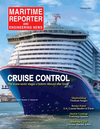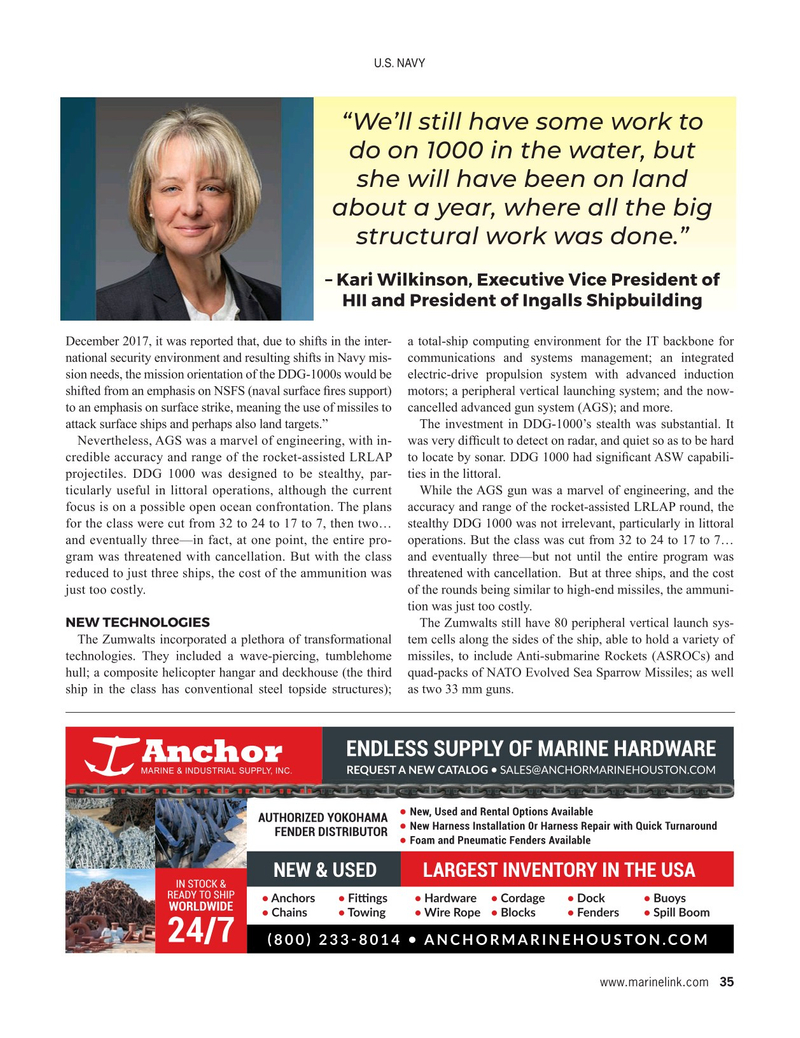
Page 35: of Maritime Reporter Magazine (February 2025)
Read this page in Pdf, Flash or Html5 edition of February 2025 Maritime Reporter Magazine
U.S. NAVY “We’ll still have some work to do on 1000 in the water, but she will have been on land about a year, where all the big structural work was done.” – Kari Wilkinson, Executive Vice President of
HII and President of Ingalls Shipbuilding
December 2017, it was reported that, due to shifts in the inter- a total-ship computing environment for the IT backbone for national security environment and resulting shifts in Navy mis- communications and systems management; an integrated sion needs, the mission orientation of the DDG-1000s would be electric-drive propulsion system with advanced induction shifted from an emphasis on NSFS (naval surface ? res support) motors; a peripheral vertical launching system; and the now- to an emphasis on surface strike, meaning the use of missiles to cancelled advanced gun system (AGS); and more. attack surface ships and perhaps also land targets.” The investment in DDG-1000’s stealth was substantial. It
Nevertheless, AGS was a marvel of engineering, with in- was very dif? cult to detect on radar, and quiet so as to be hard credible accuracy and range of the rocket-assisted LRLAP to locate by sonar. DDG 1000 had signi? cant ASW capabili- projectiles. DDG 1000 was designed to be stealthy, par- ties in the littoral.
ticularly useful in littoral operations, although the current While the AGS gun was a marvel of engineering, and the focus is on a possible open ocean confrontation. The plans accuracy and range of the rocket-assisted LRLAP round, the for the class were cut from 32 to 24 to 17 to 7, then two… stealthy DDG 1000 was not irrelevant, particularly in littoral and eventually three—in fact, at one point, the entire pro- operations. But the class was cut from 32 to 24 to 17 to 7… gram was threatened with cancellation. But with the class and eventually three—but not until the entire program was reduced to just three ships, the cost of the ammunition was threatened with cancellation. But at three ships, and the cost just too costly. of the rounds being similar to high-end missiles, the ammuni- tion was just too costly.
NEW TECHNOLOGIES The Zumwalts still have 80 peripheral vertical launch sys-
The Zumwalts incorporated a plethora of transformational tem cells along the sides of the ship, able to hold a variety of technologies. They included a wave-piercing, tumblehome missiles, to include Anti-submarine Rockets (ASROCs) and hull; a composite helicopter hangar and deckhouse (the third quad-packs of NATO Evolved Sea Sparrow Missiles; as well ship in the class has conventional steel topside structures); as two 33 mm guns.
ENDLESS SUPPLY OF MARINE HARDWARE ! &"$)$?""?!!&"$l • New, Used and Rental Options Available
AUTHORIZED YOKOHAMA • New Harness Installation 0r Harness Repair with Quick Turnaround
FENDER DISTRIBUTOR • Foam and Pneumatic Fenders Available
NEW & USED LARGEST INVENTORY IN THE USA
IN STOCK &
READY TO SHIP • Anchors • b?m]v • Hardware • ou7-]; • Dock • Buoys
WORLDWIDE • Chains • $o?bm] • Wire Rope • Blocks • Fenders • Spill Boom 24/7 ?????ƒƒƒ??????!!&"$l www.marinelink.com 35
MR #2 (34-45).indd 35 1/28/2025 9:10:58 AM

 34
34

 36
36
